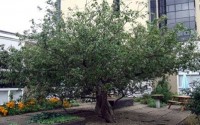Newton’s Apple Tree
- Date
- 3 Jun 2014
- Start time
- 7:30 PM
- Venue
- Tempest Anderson Hall
- Speaker
- Dr Richard Keesing

Newton’s Apple Tree
A lecture by Dr Richard Keesing, Department of Physics, University of York
The talk concerns the History of Newtons investigation of the nature of gravitation which took place in the late summer of 1665 and the part played by the fall of an apple. Some thirty years earlier an important event took place in York between the 6th and 11th June 1635, which bears heavily on the work of Newton and his subsequent writing of the Principia. Richard Norwood had arrived in York after surveying the Great North Road between the Tower of London and somewhere near the centre of York over a period of two years in order to determine accurately the size of the Earth. His results were first published in “The Seamans Practice” in 1637 and showed that the Earth was in fact about 20% larger than was commonly assumed at the time. Newton’s apple tree was first mentioned in print 1806 and it is on the subsequent history of this particular tree that this talk will largely focus.
Report
While it is unlikely that an apple actually fell on Isaac Newton’s head, sources of the time do suggest that when he saw an apple falling from a tree in his garden at Woolsthorpe Manor, it had some influence on his theory of Universal Gravitation. Dr Keesing treated us to an entertaining and informative talk about Newton’s life and the myths surrounding the apple tree itself. The tree now at Woolsthorpe, the rare variety Flower of Kent, is genetically the same as the tree in an early drawing of the garden. There was an orchard at Woolsthorpe, but this is the only apple tree in the garden itself, which is reasonable evidence of the authenticity of the the present ‘Newton Tree’. It isn’t in quite the same position as in the drawing but apparently old apple trees can walk by re-rooting from the trunk after storm damage. Cuttings from the old tree were sent to various horticultural institutions, and Dr Keesing obtained a cutting of a Kew ‘descendant’ in 1976. Planted in a specially prepared garden outside the physics department at York University, this Flower of Kent flourishes today and provides the fruit for Newton’s Apple Pie, offered to and eaten by all new students when they arrive at the university.
Almost in passing, Dr Keesing noted that the error in Newtons calculation of gravitational pull in Principia was caused by his failure to make use of Richard Norwoods measurements.
Ken Hutson